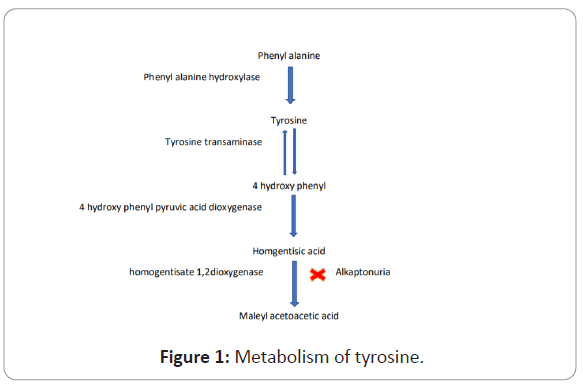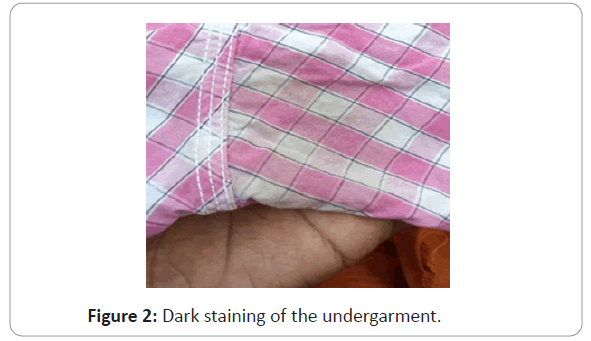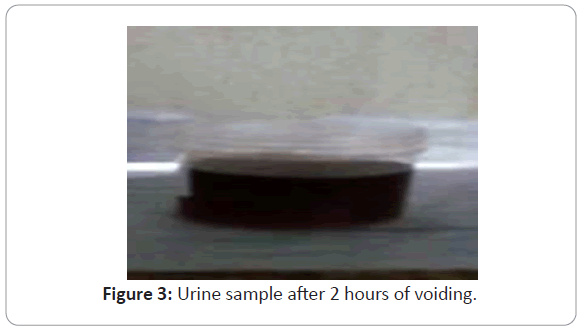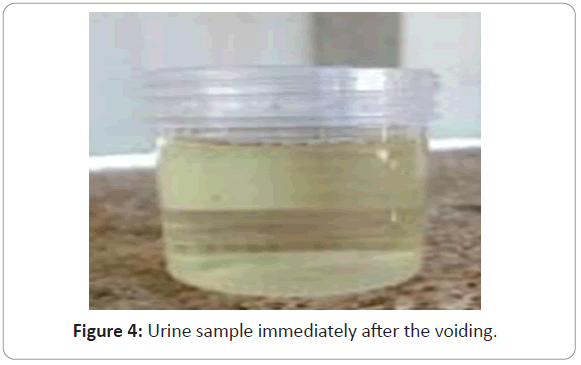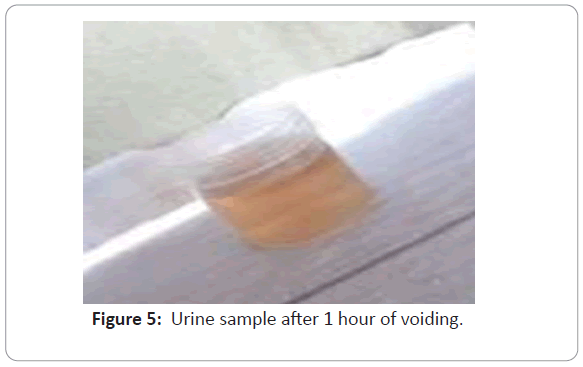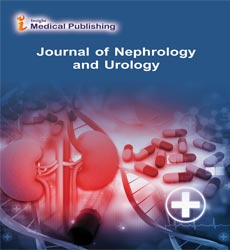Black Urine: A Tale of Two Ages
Shanmuganathan Velu*, Arul Rajagopalan, Manorajan Rajendran, Jegan Arunachalam, Arun Prasath, Rakesh Durai, Benoy Varghese, Niranjan Raja and Shiva Kumar Ammayappan
Department of Nephrology, Madurai Medical College & Government Rajaji Hospital, Madurai, Tamil Nadu, India
- *Corresponding Author:
- Shanmuganathan
Velu
Department of Nephrology
Madurai Medical College & Government Rajaji Hospital
Madurai, Tamil Nadu
India
E-mail: drvsnathan85@gmail.com
Received Date: May 21, 2021; Accepted Date: June 04, 2021; Published Date: June 11, 2021
Citation: Velu S, Rajagopalan A, Rajendran M, Arunachalam J, Prasath A, et al. (2021) Black Urine: A Tale of Two Ages. J Nephrol Urol Vol.5 No.3: 6.
Abstract
Alkaptonuria is a rare inborn error of metabolism with autosomal recessive inheritance with a mutation in homogentisate 1,2-di oxygenase. It results in excessive excretion of homogentisic acid in the urine, ochronosis, and debilitating arthritis of the spine and large joints. In this report 25-year male presented with darkening of urine and under garments. Lab findings are compatible with the diagnosis of Alkaptonuria. Treatment was initiated and patient is on follow up.
Keywords
Alkaptonuria; Black urine; Homogentisate
Introduction
Alkaptonuria is an autosomal recessive inherited disorder that occurs due to the deficiency of homogentisate 1,2-dioxygenase enzyme involved in the tyrosine metabolism [1] (Figure 1). Alkaptonuria is one of the first conditions in which Mendelian recessive inheritance was proposed. The incidence of alkaptonuria is 1 in 2,50,000 to 1 in 10,00,000 [2]. Pollack et al. mapped the alkaptonuria gene in chromosome 3q2. Since the homogenitisic acid has high affinity to alkalis, it is named as alkaptonuria [3]. Acidic urine in alkaptonuria may not become dark even after many hours of standing. Alkaptonuria is a condition which is present at birth, but morbidity occurs years later which present as ochronosis or arthritis.
Case Presentation
A 25 year old male came with the history of dark staining of dress and undergarments (Figure 2) since childhood. He noticed change in color of urine to black (Figure 3) when left standing for few hours which was clear during voiding (Figure 4). There was no history of joint pain, visual disturbances and skin pigmentation. He was born of non-consanguineous marriage and there was no history of similar complaints for either of the parents.
Discussion
Alkaptonuria is due to the deficiency of homogentisic acid oxidase resulting in both intra and extra cellular accumulation of homogentisic acid. It is further oxidized to benzoquinonine acetate which polymerizes to form melanin like substances leading to its deposition in cartilage and other fibrous tissue and skin [4].
In infants, diaper staining is the most important sign of alkaptonuria. One of the first symptoms is darkening of urine on standing [5]. Many persons are asymptomatic until adulthood. In 4th decade external signs of homogentisic acid deposition manifested as pigmentation in sclera or the cartilage of the ear occur. Most common complication in alkaptonuria is ochronotic spondyloarthropathy. Alkaptonuric ochronosis can lead to more brittle cartilages and fracture may happen. Involvement of intervertebral discs at thoracic and lumbar levels occurs in 50% of patients. Spontaneous rupture of Achilles and quadriceps tendon is also reported [6]. Aortic leaflets and mitral leaflets may also be involved and coronary artery calcification is seen in 50% of patients below 60 years [7]. A heavy deposition in the larynx, trachea bronchial tree and esophagus may result in hoarseness of voice and dysphagia. The disease is more severe in men, although the incidence in the two sexes is equal. Arthritis is the only disabling effect of this condition and occurs in almost all patients as age advances. Since our patient is 25 years old, ochronosis, cardiac and vertebral involvement has not yet developed.
Kidney disease in alkaptonuria is relatively rare. Renal biopsy shows pigment deposition and chronic interstitial nephritis features which are suggestive of causal relationship leading to ochrontic nephropathy [8,9]. Reports suggest that nephrolithiasis is common in alkaptonuria and the calculi are composed of ochronotic pigment and calcium salts [10]. Homogentisic acid acts as a chemical irritant causing inflammation and binds to connective tissue altering the structure leading to the stone formation [11]. Prostatic calculi are one of the manifestations of alkaptonuria [12-15]. Intra prostatic reflux of urine containing high levels of homogentisic acid is responsible for prostatic calcification. In our case, patient’s grandfather was diagnosed to have prostate calcification. Active surveillance for cardiac, renal, prostatic complications should be done after 4th decade. In our case patient’s grandfather was diagnosed to have prostate calcification. Alkaptonuria does not cause developmental delays or cognitive impairment and does not affect life span.
Diagnosis of alkaptonuria is made upon identification of symptom, detailed history and clinical evaluation and variety of tests. Addition of ferric chloride to the urine that changes the urine colour to black is the most commonly used diagnostic test for alkaptonuria (Figure 5). Ammoniacal silver nitrate test is also used for diagnosis. Gas chromatography and mass spectrometry is also used to check quantitative level of homogentisic acid in urine. DNA analysis of mutated homogentisate 1, 2 dioxygenase gene is diagnostic of alkaptonuria.
Conclusion
Treatment for alkaptonuria is Vitamin C at a dose of 1 g/day recommended for older children and adults. The antioxidant nature of ascorbic acid inhibits polymerization of homogentisic acid and its deposition in the cartilage which will retard the progression of the disease. With treatment of ascorbic acid, the level of excretion of homogentisic acid did not change, whereas its derivative, benzoquinone acetic acid completely disappeared from the urine. Low protein diet especially in phenylalanine amino acids helps in reducing the progression of disease. Aspartatamine should also be avoided. Nitisinone, an inhibitor of enzyme 4-hydroxyphenyl pyruvate dioxygenase will reduce the excretion of homogentisic acid, but its long term safety profile and efficacy is yet to be proved. Anti-inflammatory therapy and increasing the muscle strength by swimming would also be useful for joint pains.
Physician involved in the care of patients with musculo-skeletal problems should be aware about Alkaptonuria particularly in a patient with degenerative arthropthy more progressed than expected for patient age.
References
- Phornphutkul C, Introne WJ, Perry MB, Bernardini I, Murphey DM et al. (2002) Natural history of alkaptonuria. N Engl J Med 347: 2111-2121.
- Garrod AE (1902) The incidence of alkaptonuria: A study in chemical individuality. Lancet 160: 1616-20.
- Kant R, Barnwal S and Singh A (2005) Alkaptonria presenting as spondyloarthropathy in an elderly. J Ind Acad geria 2: 89-90.
- Tharini GK, Ravindran V, Hema N, Prabhavathy D and Parveen B (2011) Indian J Dermatol 56: 194-196.
- Verma SB (2005) Early detection of alkaptonuria. Indian J Dermatol Venereol Leprol 71: 189-91.
- Perry MB, Suwannarat P, Furst GP, Gahl WA and Gerber LH (2006) Musculoskeletal findings and disability in alkaptonuria. J Rheumatol 33: 2280-5.
- Ersin MD, Casselma FPA and Vanermen H (2004) Cardiac ochronosis. Tex Heart Inst J 31: 445-7.
- Kazancioglu R, Tayan I, Aksak F, Durak H, Kumbasar B et al. (2004) Alkaptonuria and renal failure. J Nephrolo 17: 441-445.
- Venkatesan VS, Chandra B, Graziano V, Steinlauf P, Marquet E et al. (1992) Alkaptonuria and renal failure. Mod Pathol 5: 464-471.
- Sutor DJ, Wolley SE and Krizek V (1970) The compostion of calculi from patients with alkaptonuria. Br J Urol 42: 386- 388.
- Raina S, Mahesh DM, Kaushal SS, Gupta D, Dhiman DS et al. (2008) Alkaptonruia and intramedullary calcification. J Assoc Physicians India 56: 552-5.
- Strimer RM and Morin LJ (1997) Renal, vesical and prostatic calculi associated with ochronosis. Urology 10: 42-43.
- Mayatepek E, Anninos A, Muller E and Kallas K (1998) Effects of ascorbic acid and low protein diet In alkaptonuria. Eur J Pediatr 157: 867-8.
- Anikster Y, Nyhan WL and Gahl WA (1998) NTBC and alkaptonuria. Am J Hum Genet 63: 920-1.
- Suwannarat P, O’Brien K, Perry MB, Sebring N, Bernardini I et al. (2005) Use of nitisinone in patients with alkaptonuria. Metabolism 54: 719-28.
Open Access Journals
- Aquaculture & Veterinary Science
- Chemistry & Chemical Sciences
- Clinical Sciences
- Engineering
- General Science
- Genetics & Molecular Biology
- Health Care & Nursing
- Immunology & Microbiology
- Materials Science
- Mathematics & Physics
- Medical Sciences
- Neurology & Psychiatry
- Oncology & Cancer Science
- Pharmaceutical Sciences
